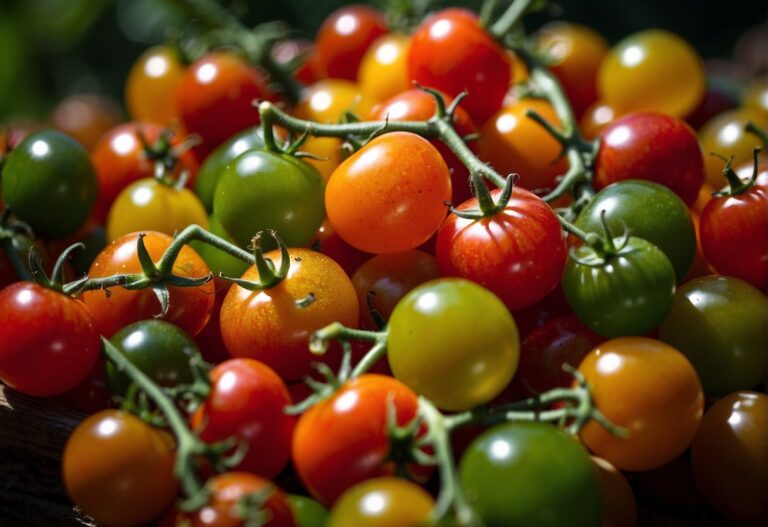Aphids on Tomato Plants: How to Control Them
If you’re a tomato grower, you know how frustrating it can be to find aphids on your plants. These tiny insects can cause significant damage to your tomato plants and reduce your yield. Fortunately, there are steps you can take to prevent and manage aphid infestations.

Understanding Aphids on Tomatoes
Aphids are small, soft-bodied insects that feed on the sap of plants. They reproduce quickly and can quickly take over a plant if left unchecked. Aphids on tomatoes can cause stunted growth, yellowing of leaves, and even the death of the plant in severe cases.
Identifying Aphid Infestations
Identifying an aphid infestation on your tomato plants is relatively easy. Look for small, pear-shaped insects that are usually green or yellow in color. They can be found on the undersides of leaves, on stems, and even on the fruit of the plant. You may also notice a sticky residue on the leaves, which is a sign of aphid activity.
Key Takeaways
- Aphids are small insects that feed on the sap of plants and can cause significant damage to tomato plants.
- Identifying aphid infestations on tomato plants involves looking for small, pear-shaped insects that are usually green or yellow in color.
- Preventing and managing aphid infestations on tomato plants involves using a variety of strategies, including companion planting, physical removal, and the use of insecticidal soaps or oils.
Understanding Aphids on Tomatoes

If you are a tomato gardener, you may have encountered aphids on your plants. These tiny insects are a common pest that can cause significant damage to your tomato crop if left unchecked. In this section, we will explore the life cycle of aphids and the common types of aphids that can infest your tomato plants.
Life Cycle of Aphids
Aphids have a relatively simple life cycle. They reproduce asexually, meaning that females can give birth to live young without the need for fertilization. This means that aphids can reproduce rapidly, with populations growing quickly under favorable conditions.
Aphids go through several stages of development, starting as eggs and progressing through several nymphal stages before reaching adulthood. The entire life cycle can take as little as a few weeks, depending on the temperature and other environmental factors.
Common Types of Aphids on Tomatoes
There are several species of aphids that can infest tomato plants, each with its own unique characteristics. Some of the most common types of aphids that you may encounter on your tomato plants include:
- Green peach aphids: These aphids are small and green, with a distinctive V-shaped pattern on their backs. They are a common pest of many crops, including tomatoes.
- Potato aphids: These aphids are yellow-green and have a waxy coating that makes them difficult to control. They can cause significant damage to tomato plants if left unchecked.
- Foxglove aphids: These aphids are pale yellow and have long, slender bodies. They are a common pest of foxglove plants but can also infest tomatoes.
It is important to be able to identify the species of aphids that are infesting your tomato plants so that you can choose the most effective control methods.
Identifying Aphid Infestations

If you’re wondering whether your tomato plants have aphids, there are a few visual signs to look out for. Here are some of the most common:
Visual Signs of Aphids
- Small, soft-bodied insects: Aphids are usually tiny and soft-bodied, and they can range in color from green to black to gray to pink to purple. They are often found on the undersides of leaves and feeding on new, soft growth.
- Honeydew: Aphids excrete a sticky substance called honeydew, which can accumulate on leaves and surrounding areas. If you see a sticky film on your tomato plants, it could be a sign of an aphid infestation.
- Curling or distortion of leaves: As aphids feed on the sap of tomato plants, they can cause leaves to curl or become distorted. If you notice leaves that are curling or twisting, it could be a sign of aphids.
- Stunted growth: If your tomato plants are not growing as quickly or as healthily as they should be, it could be a sign of an aphid infestation. As aphids feed on the sap of tomato plants, they can cause stunted growth and a decline in vigor.
Effects of Aphids on Tomato Plants
Aphids can have a number of negative effects on tomato plants. Here are some of the most common:
- Reduced yield: As aphids feed on the sap of tomato plants, they can cause a reduction in yield. If you notice that your tomato plants are producing fewer tomatoes than they should be, it could be a sign of an aphid infestation.
- Misshapen fruit: If aphids are feeding on the flowers or young fruit of tomato plants, they can cause the fruit to become misshapen or deformed.
- Spread of disease: Aphids can spread plant viruses, which can cause a number of different diseases in tomato plants. If you notice that your tomato plants are showing signs of disease, it could be a sign of an aphid infestation.
Now that you know how to identify aphid infestations and the effects they can have on tomato plants, it’s time to learn how to control and prevent them.
Preventative Measures
If you want to prevent aphids from infesting your tomato plants, there are a few measures you can take. In this section, we’ll discuss two main types of preventative measures: cultural practices and natural predators/biological controls.
Cultural Practices
Cultural practices involve taking care of your tomato plants in a way that makes them less susceptible to aphid infestations. Here are a few cultural practices you can follow:
-
Proper watering: Water your tomato plants regularly to keep them healthy. However, be careful not to overwater them, as this can make them more susceptible to aphids.
-
Fertilization: Use a balanced fertilizer to keep your tomato plants healthy. However, be careful not to over-fertilize them, as this can also make them more susceptible to aphids.
-
Pruning: Prune your tomato plants regularly to remove any dead or diseased leaves. This will help keep your plants healthy and less susceptible to aphids.
-
Companion planting: Plant other plants near your tomato plants that repel aphids, such as marigolds, garlic, or chives.
Natural Predators and Biological Controls
Another way to prevent aphids from infesting your tomato plants is to introduce natural predators or use biological controls. Here are a few options:
-
Ladybugs: Ladybugs are natural predators of aphids and can help keep their populations in check. You can attract ladybugs to your garden by planting flowers they like, such as daisies or sunflowers.
-
Parasitic wasps: Parasitic wasps lay their eggs inside aphids, which then hatch and kill the aphids. You can purchase parasitic wasps online or from a garden center.
-
Neem oil: Neem oil is a natural insecticide that can be used to repel aphids. You can spray it on your tomato plants every few weeks to keep aphids away.
By following these preventative measures, you can keep your tomato plants healthy and free from aphids.
Management and Control Strategies
If you have discovered aphids on your tomato plants, there are several management and control strategies that you can use to get rid of them. In this section, we will discuss both organic remedies and chemical treatments.
Organic Remedies
There are several organic remedies that you can use to control aphids on your tomato plants. Here are some of the most effective ones:
-
Insecticidal soap: Insecticidal soap is a non-toxic, natural way to kill aphids. It works by breaking down the aphids’ waxy outer coating, which allows the soap to penetrate their bodies and kill them. You can buy insecticidal soap at most garden centers, or you can make your own by mixing one tablespoon of dish soap with one quart of water.
-
Neem oil: Neem oil is a natural insecticide that is derived from the neem tree. It works by disrupting the insect’s hormonal balance, which prevents it from reproducing and feeding. To use neem oil, mix one tablespoon of neem oil with one quart of water and spray it on your tomato plants.
-
Beneficial insects: There are several beneficial insects that feed on aphids, including ladybugs, lacewings, and parasitic wasps. You can attract these insects to your garden by planting flowers that they like, such as marigolds, daisies, and sunflowers.
Chemical Treatments
If organic remedies are not effective, you may need to use chemical treatments to control aphids on your tomato plants. Here are some of the most common chemical treatments:
-
Insecticidal sprays: Insecticidal sprays are the most common chemical treatment for aphids. They work by killing the insect on contact or by disrupting its nervous system. However, they can also harm beneficial insects and other wildlife, so use them sparingly.
-
Systemic insecticides: Systemic insecticides are absorbed by the plant and can kill aphids that feed on the plant’s sap. However, they can also harm beneficial insects and other wildlife, so use them sparingly.
Remember, prevention is the best strategy for controlling aphids on your tomato plants. Regularly inspect your plants for aphids, and use the management and control strategies discussed in this section to keep them at bay.
Monitoring and Maintenance
Regular Inspection
To keep aphids off your tomato plants, you need to be vigilant and inspect them regularly. Check for aphids on the underside of the leaves, along the stems, and on the fruit. Look for small, pear-shaped insects that are usually white, gray, brown, red, or green. You should also inspect the plants for any signs of damage, such as curled or distorted leaves, yellowing, and stunted growth.
It is recommended that you inspect your tomato plants at least once a week during the growing season. This will help you catch any aphid infestations early and prevent them from spreading.
Post-Treatment Care
After treating your tomato plants for aphids, it is important to monitor them closely to ensure that the treatment was effective. Check the plants regularly for any signs of new aphid activity.
In addition, it is important to take care of your tomato plants to ensure that they remain healthy and strong. This includes providing them with adequate water, nutrients, and sunlight. You should also remove any dead or damaged leaves or stems, as these can attract pests and diseases.
By regularly inspecting and maintaining your tomato plants, you can help prevent aphid infestations and keep your plants healthy and productive.
Frequently Asked Questions
What are some natural remedies to treat aphids on tomato plants?
If you’re looking for a natural remedy to treat aphids on tomato plants, you can try using companion planting. Planting herbs like basil, mint, and thyme near your tomato plants can help repel aphids. You can also try spraying your tomato plants with a mixture of vegetable oil and water. The oil coats the aphids and suffocates them within minutes.
Can soapy water effectively eliminate aphids on my tomato plants?
Yes, soapy water can effectively eliminate aphids on your tomato plants. Mix a few drops of dish soap with water and spray it onto your tomato plants. The soap will break down the aphids’ waxy outer coating, allowing the water to penetrate their bodies and kill them.
How can I identify and deal with different colored aphids on my tomatoes?
Aphids can be green, pink, purple, gray, or black in color. To identify them, look for tiny, soft-bodied insects usually found on the underside of leaves and feeding on new, soft growth. To deal with different colored aphids on your tomatoes, you can try using natural remedies like companion planting or soapy water. You can also try using insecticidal soap or neem oil, which are both effective at killing aphids.
What does the damage caused by aphids look like on tomato leaves?
The damage caused by aphids on tomato leaves can look like yellowing, curling, or stunted growth. You may also see a sticky substance on the leaves, which is honeydew, a waste product of aphids.
Are tomato seedlings at risk of aphid infestation, and how can I protect them?
Yes, tomato seedlings are at risk of aphid infestation. To protect them, you can try using row covers or insecticidal soap. You can also try companion planting with herbs like basil, which can repel aphids.
Is there a way to permanently remove aphids from my tomato garden?
Unfortunately, there is no permanent way to remove aphids from your tomato garden. However, you can control their population by using natural remedies like companion planting, soapy water, or insecticidal soap. Regularly inspecting your tomato plants for aphids and removing them by hand can also help keep their population under control.




